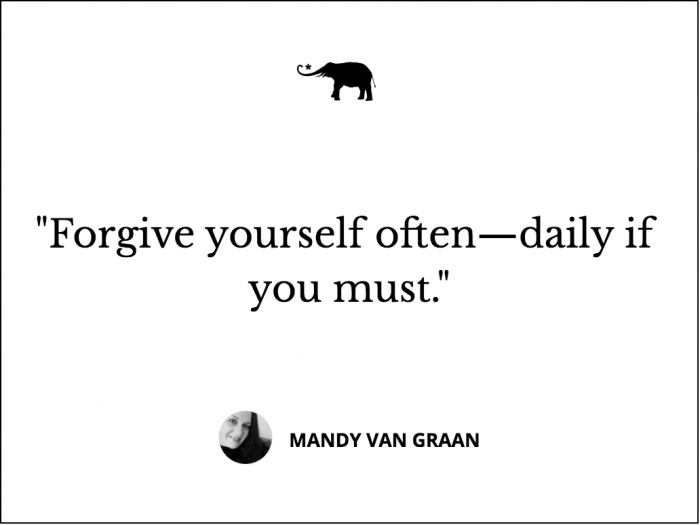View this post on Instagram
“Do you fully accept yourself?” someone asked me.
I had a million to-do lists going on in my head during that conversation; I was distracted. I was about 80 percent present, with the other 20 in my head:
“Finish the report when you get home.”
“Don’t forget to let them know you can’t make yoga on Wednesday.”
“Did we run out of toothpaste or shampoo? F*ck, I can’t remember. This is why you need to make a list!” (Grocery list self-beration, dare us to make it a hashtag?)
This straightforward and simple question felt like it had been shouted rather than asked, and all of my attention honed in on it. My eyes fixed squarely on the other person, and I somewhat pathetically mumbled, “Um, I’m not really sure.”
I followed it with a question of my own, “What’s the difference between self-esteem and self-acceptance?”
The response, “You are asking the right question.”
The context of the conversation is irrelevant, but when I left, I caught a glimpse of myself in a mirror. I surrendered to a moment of stillness, simply looking back at myself and internally asked, “Do you fully accept yourself?”
Naturally, being a writer, I needed to sit with this awhile. I needed to process what it meant for me, and then, as is always the case, I feel that beautiful spark of inspiration to waffle about it to you, dear reader.
So, what is the difference between self-esteem and self-acceptance?
Self-esteem is having confidence in yourself and your talents. If you have a high self-esteem, you feel worthy of having good and positive experiences, and you feel strong enough to handle difficult situations.
Self-acceptance and self-esteem are most certainly connected, but the difference is the depth of the Grand Canyon. Self-acceptance is when you embrace every single part of yourself, your strengths and your weaknesses.
How many of us can say that we fully accept and embrace the ugly, tattered, resentful, angry parts of ourselves? Not many would be my guess.
And like an onion, we peel back another layer of understanding: why is it so hard for us to accept ourselves?
From the moment we enter the world, how we fit into it is determined and highly influenced by our upbringing and our caregivers. If we were raised in homes where we were encouraged, loved, and accepted, our self-acceptance would be a reflection of that. If we came from trauma or dysfunction, our self-acceptance is more often than not shrouded in shame.
And with any kind of self-developmental work for ourselves, we need some practical, get-your-hands-dirty, do-the-shadow-work kind of tools:
Create Rituals
Rituals are powerful self-acceptance tools, and the reason for this is their repetition. When we do something consistently, it starts to stick and forms into a habit.
I started a self-acceptance ritual that was planted in my mind by a fellow Elephant Journal writer—every time I look in the mirror, whether I’m brushing my teeth, getting started for the day, or catching a glimpse of myself somewhere, I will really look at myself and say, “I love you.”
Granted in the beginning, I felt stupid, and it felt foreign, and I’m sure a stranger or two has caught me and wondered if I’m a narcissist.
But over a period of consistently doing this, I found myself saying it and then smiling—a kind of soul smile. It’s no longer forced or feels fake, I have found joy in this ritual. I created it and I nurtured it, and continued to do so even when it felt inauthentic.
Make a Weakness List
We all have a myriad of weaknesses, and I believe wholeheartedly that this will shift and change with time, particularly if we become aware of where we are weak.
I sat with a shaky hand and a fragile spirit and wrote down a list of where I believed I was weak. Some of the things I wrote down surprised me because I may not have been fully aware of it until it was in black and white.
I wrote things like:
I struggle to ask for help when I need it.
I struggle to control my anger when I feel anxious or stressed.
I lash out at others when they trigger my own reflected insecurities.
I often feel unsafe with other people and their intentions with me, and I would self-sabotage to prove myself right.
I don’t like looking stupid or ignorant, and I will try and hide before that happens.
When we are aware, we are empowered and we understand that we may—more often than not—be reacting out of weakness from our wounds that are still healing. So, to get my hands dirty, I did little exercises with each weakness on my list.
I asked for help, even when every fiber of my being screamed that I didn’t need it. I changed the vocabulary around anger, “I’m not angry, I’m currently struggling, and that’s okay.”
I’m spending more and more time with people I trust, admire, and feel safe with. Genuine connections with others have a profound effect on our mental and emotional well-being, and it does sometimes mean letting go of the connections that don’t support or foster that kind of growth.
And when a stupid or ignorant moment comes along, I see it as an opportunity for learning, and not a reflection of my intelligence. “Now I know” is a handy, little phrase. Be conscious of what you tell yourself, speak the same words to yourself that you would someone you love and care for, which brings me to my next point.
Use the P.E.R.T Technique
This technique was developed by Dr. Fred Luskin and was featured in his book, Forgive for Good. P.E.R.T is the Positive Emotion Refocusing Technique. The path of self-acceptance is a rough and bumpy ride, and while I am not an advocate for toxic positivity, I do believe that we can find ourselves living in negative thought patterns and they become comfortable spaces for us.
Your hurt, your pain, your sadness, your frustration all have space in your life. They need to be felt, to be processed, or they will be left to fester within you and your actions will be dictated by them. But refocusing (when we are ready) is a great tool to break free of those destructive patterns.
Gratitude is and always will be a positive emotion for me that I can ground myself in—much like the roots of a tree extending deep into the earth. When I feel myself sitting in the shadow for too long, rejecting myself, gratitude brings me back to the light—and helps me to continue working on accepting myself as a flawed but worthy human being.
Forgive Yourself
I once sat in a recovery group session and had one of the most intense moments of my life. The woman leading the group (while speaking about the amends step) looked directly at me and said,
“It’s all good and well to look for forgiveness from others, but it must first come from yourself.”
Something I had shared must have triggered resonation within her; she could see that I was riddled with self-loathing and hadn’t forgiven myself for my mistakes. By her recognizing it, she helped me to see (maybe for the first time) that forgiveness really does begin with us.
We all often get caught in ruminating over the things we cannot change, and a big part of self-acceptance is forgiving who you were, but at the same time accepting and loving that version of yourself. Find compassion for the person you were then—that needed to learn the lesson.
This is a lifetime practice because if we humans know how to do one thing really well, it’s usually f*ck sh*t up, and we learn more from our mistakes, right?
Forgive yourself often—daily if you must. Write sh*t down; there is no better clarity than pen to paper, I can promise you.
When we practice self-acceptance, it permeates through every aspect of our lives, and it reminds me of one of my favorite quotes, which I will leave you with:
“Remember, you have been criticizing yourself for years and it hasn’t worked. Try approving of yourself and see what happens.” ~ Louise Hay
~









Read 14 comments and reply